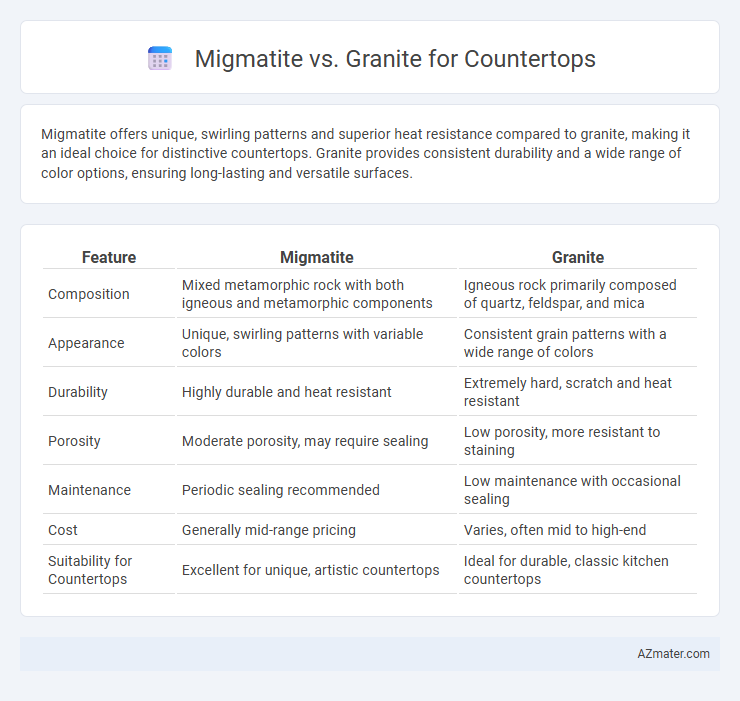Migmatite offers unique, swirling patterns and superior heat resistance compared to granite, making it an ideal choice for distinctive countertops. Granite provides consistent durability and a wide range of color options, ensuring long-lasting and versatile surfaces.
Table of Comparison
| Feature | Migmatite | Granite |
|---|---|---|
| Composition | Mixed metamorphic rock with both igneous and metamorphic components | Igneous rock primarily composed of quartz, feldspar, and mica |
| Appearance | Unique, swirling patterns with variable colors | Consistent grain patterns with a wide range of colors |
| Durability | Highly durable and heat resistant | Extremely hard, scratch and heat resistant |
| Porosity | Moderate porosity, may require sealing | Low porosity, more resistant to staining |
| Maintenance | Periodic sealing recommended | Low maintenance with occasional sealing |
| Cost | Generally mid-range pricing | Varies, often mid to high-end |
| Suitability for Countertops | Excellent for unique, artistic countertops | Ideal for durable, classic kitchen countertops |
Understanding Migmatite and Granite: Key Differences
Migmatite, a hybrid rock formed under extreme heat and pressure, exhibits a unique intermingling of metamorphic and igneous components, making it distinct from granite, a coarse-grained igneous rock composed primarily of quartz, feldspar, and mica. Granite's uniform texture and high durability make it a popular choice for countertops, while migmatite's varied mineral patterns create a visually striking, natural mosaic often valued for its aesthetic uniqueness. Understanding these key differences helps homeowners and designers choose the ideal stone based on appearance, durability, and maintenance needs.
Formation and Geological Background
Migmatite forms through partial melting during high-grade metamorphism, creating a blend of igneous and metamorphic characteristics with distinct bands of light and dark minerals. Granite is an intrusive igneous rock crystallized slowly from magma deep within the Earth's crust, composed primarily of quartz, feldspar, and mica, providing a uniform texture. The geological formation of migmatite results in unique, variegated patterns, while granite's homogenous crystalline structure offers consistent durability for countertops.
Visual Appeal: Color and Pattern Variations
Migmatite countertops showcase unique, swirled patterns with a blend of light and dark minerals creating a distinctive, natural marbled effect, often featuring hues of white, gray, and black with occasional hints of pink or green. Granite countertops offer a wide spectrum of color variations, including bold tones of red, green, blue, and traditional earth tones, with patterns ranging from speckled to veined, providing a more consistent and polished look. Both materials enhance kitchens with their natural stone aesthetics, but migmatite's complex, flowing patterns appeal to those seeking a more dynamic and organic visual texture compared to granite's classic and varied designs.
Durability and Hardness Comparison
Migmatite and granite are both durable choices for countertops, with granite exhibiting higher hardness due to its crystalline structure primarily composed of quartz and feldspar. Migmatite, a hybrid rock formed from partial melting and metamorphic processes, typically displays varied hardness, often softer in comparison to granite's consistent mineral composition. In terms of durability, granite resists scratches, heat, and stains more effectively, making it a preferred option for heavy-use kitchen surfaces.
Porosity and Stain Resistance
Migmatite exhibits lower porosity compared to granite, making it inherently more resistant to water absorption and staining. Granite countertops, while durable, often require sealing to enhance stain resistance due to their higher natural porosity. Choosing migmatite ensures a countertop surface that demands less maintenance and offers superior durability against common household stains.
Maintenance Requirements for Migmatite and Granite
Migmatite countertops require periodic sealing to prevent staining and moisture absorption due to their mixed metamorphic composition, while granite surfaces benefit from regular sealing to maintain resistance against scratches and stains. Both materials demand gentle cleaning with pH-balanced cleaners and avoidance of abrasive pads to preserve their aesthetic integrity. Migmatite's variable mineral banding might necessitate more frequent inspections for surface wear compared to granite's uniform crystalline structure.
Cost Analysis: Migmatite vs Granite
Migmatite countertops typically cost between $50 to $150 per square foot, reflecting their unique blend of metamorphic and igneous features that create intricate patterns. Granite prices range from $40 to $100 per square foot, making it a more affordable option with consistent availability and durability. The higher price of migmatite is justified by its rarity and distinctive appearance, while granite offers a cost-effective balance of strength and aesthetic appeal for kitchen countertops.
Installation Process and Considerations
Migmatite countertops require specialized fabrication due to their complex mineral composition and variable patterns, often demanding skilled stone fabricators familiar with its unique veining and potential fragility during cutting. Granite installation follows a more standardized process, with widely available expertise ensuring precise cutting, edge profiling, and mitigation of granite's inherent hardness. Both materials necessitate thorough substrate preparation and proper sealing post-installation to prevent moisture infiltration and maintain their durability and aesthetic appeal.
Environmental Impact and Sustainability
Migmatite countertops offer a unique blend of metamorphic and igneous rock properties, often sourced through quarrying methods that have varying environmental footprints compared to granite extraction, which is widely recognized for its durability and abundance. Granite mining typically involves extensive land disturbance and energy consumption but benefits from widespread availability, potentially reducing transportation emissions relative to rarer materials like migmatite. Both stones can be sustainable choices when responsibly sourced through certified quarries adhering to environmental regulations and when their longevity reduces the frequency of replacement, minimizing overall environmental impact over time.
Choosing the Best Stone for Your Countertop
Migmatite offers a unique blend of metamorphic features with swirling patterns that create a dramatic aesthetic, while granite provides consistent durability and a wide range of color options ideal for traditional countertops. Migmatite's natural veining and mineral composition can offer a more distinctive and artistic look, but granite often surpasses it in hardness and stain resistance, making it easier to maintain in high-use kitchen environments. When choosing the best stone for your countertop, consider granite for its proven resilience and variety or migmatite for a bold, natural statement piece with intricate textures.

Infographic: Migmatite vs Granite for Countertop
 azmater.com
azmater.com